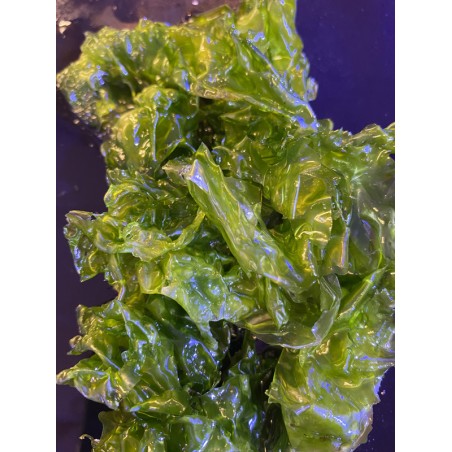Jump to:
- Description of Lettuce Algae
- Natural Habitat of Lettuce Algae
- How to culture Lettuce Alage
- Uses for Lettuce Alage
- References
Description of Lettuce Algae
Ulva lactuca is a common marine macroalgae characterized by its thin, flat sheet-like growth. It can grow up to 12 inches across but will always be only two cells thick, giving Ulva its characteristic lettuce-like translucence and ruffled edges. Ulva is typically a bright to dark green and can be attached to rocks or other surfaces or it can drift freely in the water.
Natural Habitat of Lettuce Algae
Ulva can be found worldwide in shallow marine waters. There is some debate on if Ulva found in warm-temperate to tropical areas is the same species as Ulva found in the Northeast Atlantic. Regardless, all Ulva thrives in areas of high nutrient levels such as sewage outfalls and agricultural run off areas.
How to Culture Lettuce Algae
Ulva grows best in a moderate flow area with bright full spectrum light. A moderate flow helps tumble the algae, releasing trapped air bubbles and allowing all sides of the algae to receive light and prevent surface die off. Like Chaetomorpha, Ulva prefers ammonia for photosynthesis but will switch to nitrate and phosphorus once the ammonia is depleted. Ulva typically reproduces asexually and so spawning is not a big concern, though it can occur. If you’re struggling to get your algae to grow, consider adding a small dose of iron. Very small quantities of iron are essential in photosynthesis and protein formation but can be limited in aquarium settings resulting in slow or reduced algae growth. Make sure to quarantine or at least rinse any Ulva in fresh saltwater before it is added to your tank to prevent the establishment of pests.
Uses for Lettuce Algae
With its impressive nutrient absorption skills, Ulva makes a great refugium macroalgae. While it can grow quickly, herbivorous fish including Tangs and Rabbitfish love to eat it and it can easily be taken from the refugium to feed the main tank. When placed in a refugium, Ulva will oxygenate the water and make for an attractive home for beneficial invertebrates and copepods. Ulva lactuca is considered one of the most useful macroalgaes and applications include agriculture, food, medicine, and pharmacology. It is often eaten in salads, soups, or as a garnish.
Emily Strunk July 25th, 2022
References
Clean sea lettuce - live Ulva Lactuca algae - algaebarn. Bulk Reef Supply. (n.d.). Retrieved July 22, 2022, from https://www.bulkreefsupply.com/clean-sea-lettuce-live-ulva-lactuca-algae-algaebarn.html
G.M. Guiry in Guiry, M.D. & Guiry, G.M. 09 June 2022. AlgaeBase. World-wide electronic publication, National University of Ireland, Galway. https://www.algaebase.org; searched on 18 July 2022
Pleskun, T. (2021, April 12). Ulva Lactuca: The many benefits of reef-grown Sea Lettuce. Pod Your Reef. Retrieved July 22, 2022, from https://www.podyourreef.com/blogs/care/ulva-lactuca-the-many-benefits-of-reef-grown-sea-lettuce
Sea lettuce • ulva lactuca. Biodiversity of the Central Coast. (n.d.). Retrieved July 22, 2022, from https://www.centralcoastbiodiversity.org/sea-lettuce-bull-ulva-lactuca.html
The seaweed site: Information on marine algae. Seaweed.ie :: Ulva lactuca. (n.d.). Retrieved July 22, 2022, from https://www.seaweed.ie/descriptions/Ulva_fenestrata.php
Ulva Lactuca (sea lettuce). Seaweed Solutions. (n.d.). Retrieved July 22, 2022, from https://seaweedsolutions.com/sea-lettuce-ulva-lactuca

